The last big race of the season and one of the most beautiful courses, Il Lombardia often has a wistful feel, the anticipation of a great race on a fine course but the nagging feeling that it’s all about to end.
This Saturday’s edition promises plenty with Tadej Pogačar and Jonas Vingegaard among the top contenders.
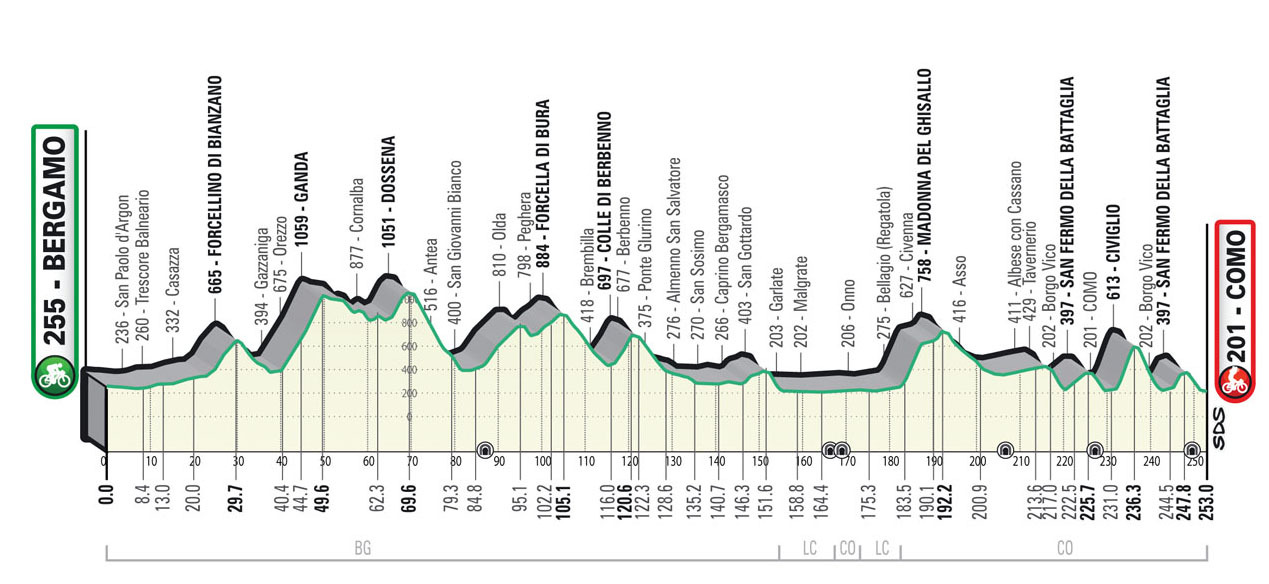
The Route: Bergamo to Como via the scenic route with 253km and 4,500 metres climbing. The race changes its course but keeps the regular haunts. It starts with a dash out of Bergamo across the plains for 20km to the first climb, the Forcellino di Bianzano. This is a wide and steady mountain pass on both sides. The road gets harder from Ganda onwards, it’s narrower and more irregular here but with a long way to go it’s not too tactical. Then it’s across to the Forcella di Bura, home of Taleggio cheese before a dip into Brembilla and the Berbenno. All this will have the effect of softening up the peloton, adding a lot of climbing and then the race heads to the swank shores of Lake Como.
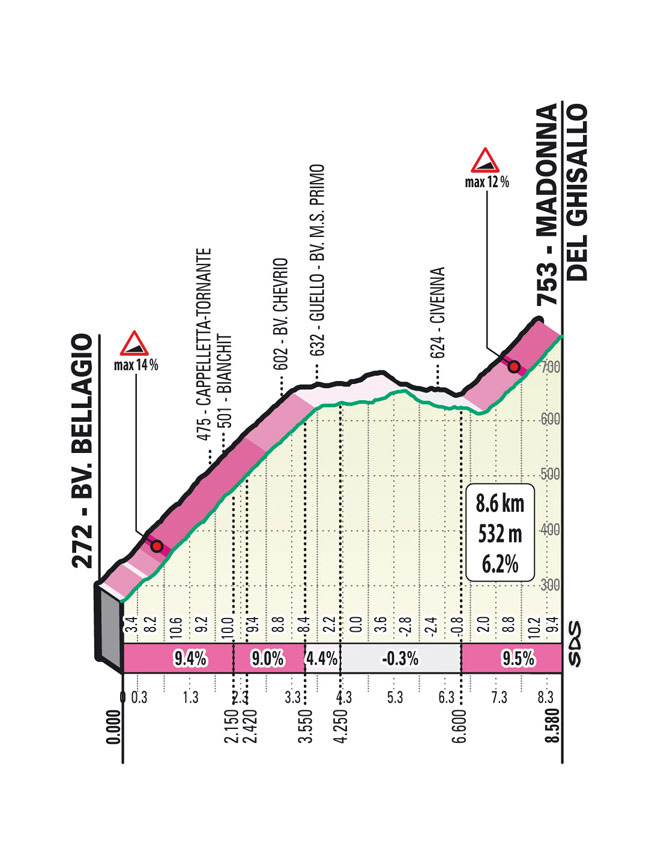
With 70km to go the climb of the Madonna del Ghisallo begins. It’s in two parts and the hardest part is the start out of Bellagio with some 10-15% sections. It levels out through Guello before a more tame rise over the top and then a twisty descent down to Asso after which the road heads for Como.

The novelty this year is in the repetition of the climbs around Como. The road to San Fermo della Battaglia is climbed once, then there’s the ascent to Civiglio, then San Fermo again. Of the two climbs, Civiglio is harder but it opens with a long straight ramp up before the ten hairpins starts. San Fermo’s not easy, a tight turn to start with puts anyone ten wheels back in trouble to start with before the narrow road twists up through the woodland.
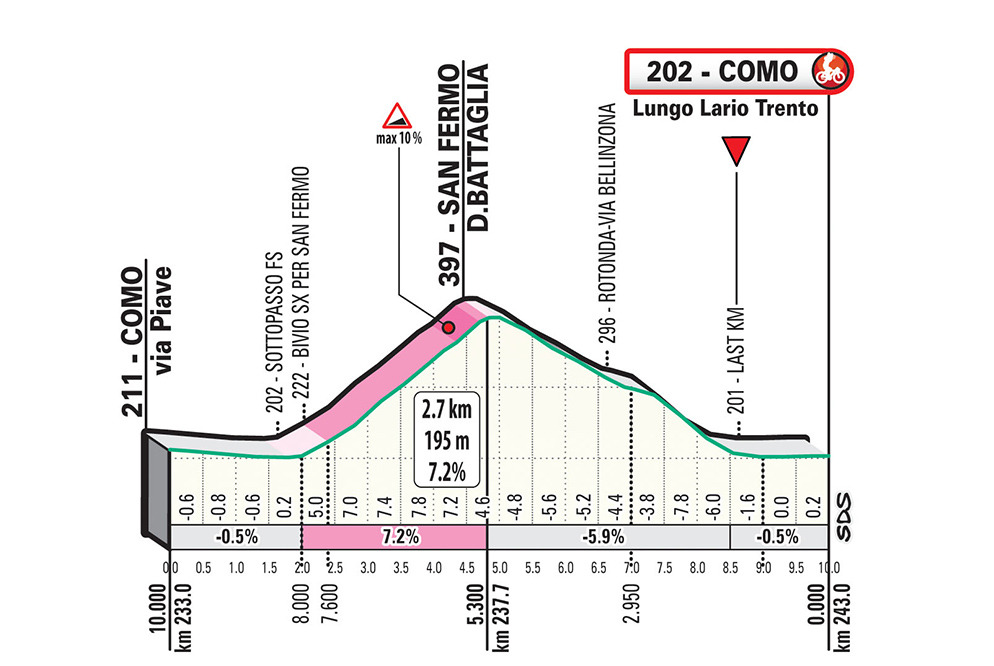
The Finish: another time up to San Fermo, a series of 7% ramps winding up to the 5km to go point and then followed by a regular descent with tight bends which flattens out with just over 1km to go.
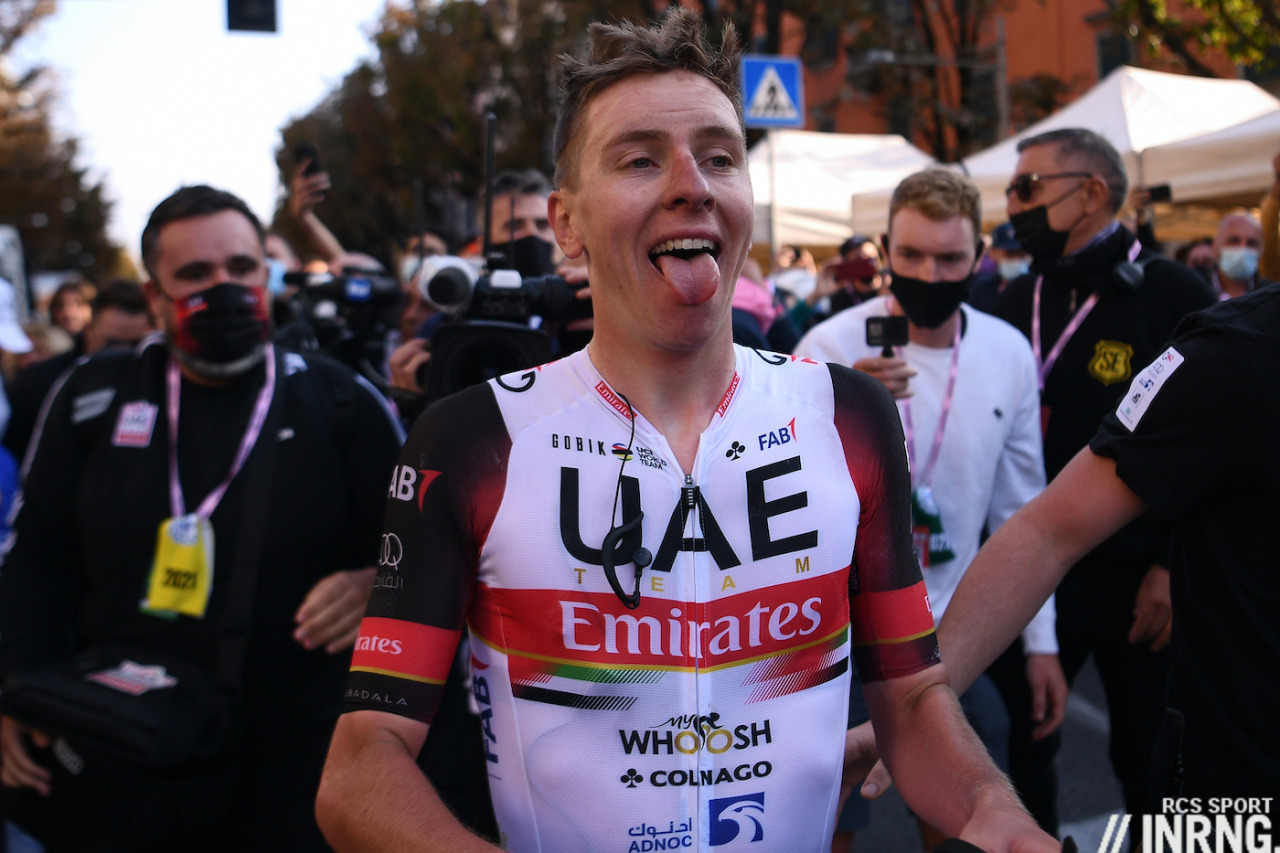
The Contenders: Tadej Pogačar (UAE) won last year, although on a very different course. He’s still the prime pick because he can win on many terrains, see his win during the week in the Tre Valli Varesine where he took the sprint from a 20 rider group although he did get dropped in a straight uphill contest in Emilia last Sunday too. His UAE team is very strong, helpers like Diego Ulissi, Alessandro Covi, Marc Hirschi or João Almeida are plausible winners too if not this year then another so it’ll be interesting to see how the team plays its cards, presumably to make the race as hard as possible and force a selection where Pogačar has a team mate or two and few rivals are left. That’s all too obvious and many other teams know they’ll need to find a different route to victory.

Jonas Vingegaard (Jumbo-Visma) is in form after two stage wins and second overall in the recent CRO Race but can he stay the distance over 250km here? He’s incisive uphill but much less of a threat in a sprint so he’ll need to launch on the final climbs and ideally arrive solo as playing the odds in a sprint is a tough ask. Koen Bouwan packs a tidy sprint and Tobias Foss brings more options too.
Julian Alaphillipe (Quick-Step) ought to win this race one day. Only 2022’s been a rough season for him by his standards. If he’s due a holiday he might still prefer another week or two of racing as he tries to recover form. He’s suited to the sharp climbs, the twisting descents and has a good sprint from a small group. Andrea Bagioli is a local capable of winning but that would be an upset.
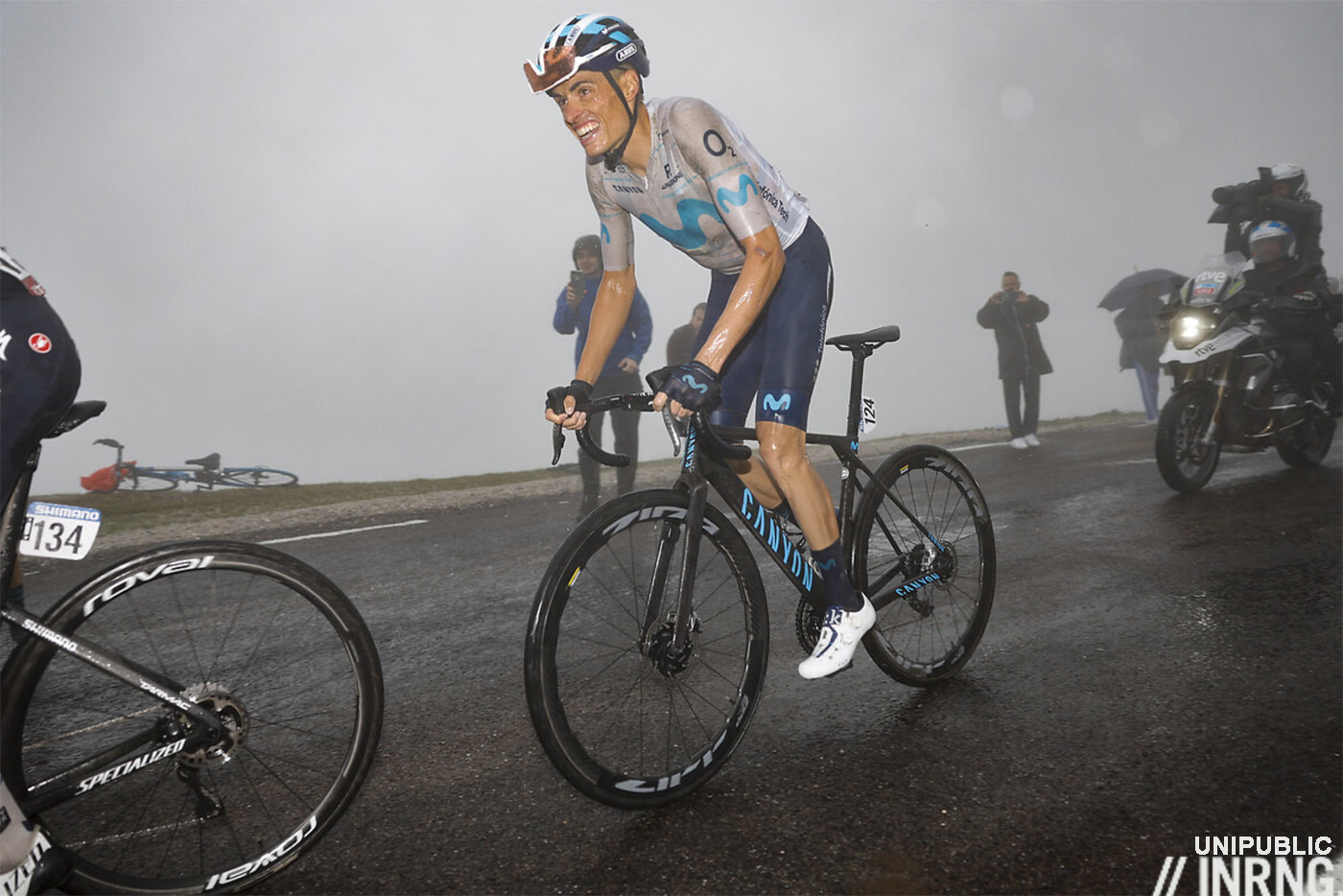
Enric Mas (Movistar) could have put his feet up after the Vuelta but he’s in great form right now having just won the Giro dell’Emilia and in style, dropping Pogačar on the final time up the climb. He’ll find a win in Lombardia harder as there’s no summit finish and the twisty roads will tax him. Alejandro Valverde is a Plan B for the team in his last race and if it’s hard to see him winning as his sprint is not what it was, he can find a way to the podium.

Outsiders include Bauke Mollema (Trek-Segafredo) who is in perfect late-season form, just under the radar so he can hit rivals when they least expect it and replicate his win from 2019, team mate Mattias Skjelmose can also make similar moves. Can Matej Mohorič (Bahrain) cope with the climbs, because he’s got a good finish and even if dropped late can slide back into contention.
Bora-Hansgrohe bring a very strong team but how to win, they’ll need to stir up the race early and try moves with Sergio Higuita and Aleksandr Vlasov. They’ll find allies here in Ineos who will also want to get UAE on the back foot in order to increase the chances for Adam Yates and Dani Martinez.
EF Education’s new signing and local Andrea Piccolo is doing well but unproven over this distance, Neilson Powless is more experienced.

Finally Vincenzo Nibali (Astana) bows out and is still capable of a final flourish as we saw with his attacks in the Tre Valli Varesine but a third win is asking too much, Samuele Battistella could feature as well.
| Tadej Pogačar | |
| – | |
| Enric Mas | |
| Alaphilippe, Bagioli, Vingegaard, Higuita | |
| Vlasov, Valverde, Martinez, Mollema |
Weather: sunshine and some clouds, 23°C.
TV: the race starts at 10.00am CEST with Italian channel RAI broadcasting a show from the start but coverage of the race on RAI and Eurosport/GCN is from 12.30pm onwards with Ghisallo climb from 3.00pm and the finish due around 5.00pm.



I have just learnt that this is the race where Gimondi beat Merckx … and the patron saint of cycling hangs out.
There’s the chapel on the Ghisallo, but also a cycling museum, a great viewpoint of the lake, and also a fountain for water bottles. You have to be really determined, or in a race, not to stop here.
I don’t know what the organisers have got against the old Ghisallo-Civiglio-San Fermo finish but I used to like it… this is still too waited towards climbers. They seem to have an obsession with wanting GC men to win this race now. Still, it’s better than it was without the Muro.
Seems like quite a thin field this year and I’m expecting Pogacar to win quite easily from Mas, unless there’s a stare down on the Civiglio that leaves Mohoric still in contention. In which case his descending ability may come into play😒.
They seem to be set against repeats, the course now seems to change each time. It does feel unnecessary, why change a winning formula but also no bad thing as it stops the bunch collectively deciding how to race things, if the winning move goes on a certain climb for a couple of years then everyone races it the same again and again, see Liège-Bastogne-Liège, at least until Evenepoel decided otherwise this year.
That’s an interesting aspect, INRNG. And who knows maybe that’s really the driving motivation behind those route changes. I always liked the Bergamo to Como version more – as nearly all TV spectators I suppose -, with my only gripe being the somewhat long stretch of flat road after the Sormano descent (which I’ll miss as bike handling skills are a fundamental part of that sport IMHO).
That flattish stretch – where guys who start the final early are at a disadvantage – is now considerably shorter but still pretty long. And we have 800 metres of elevation gain within the 28 km of the real finale before the final descent.
So a plenty hard finale to make sure that the best man of the day wins, and that tactics won’t really matter. You either have the legs to stay in touch with the best guys or you’ll not win it.
Bala and The Shark should agree to join forces for a massive attack together on the Ghisallo climb. Hopefully other hopefuls will join, so they’ll reach the finale with an advantage over Pogi and the other favorites. And then we’ll see how much horsepower is left in those “old” pairs of legs 😉.
The most curious aspect about this edition is how hard the course is in its first half, incredibly far from the line; so much that you can actually race it mildly, even if a break is out there, given that the peloton will get a huge advantage against any break in the flattish stretch from km 120 to 180, and you might even include Ghisallo to say that it’s the only climb in 100 kms (!!!), 120 to 220.
However, not only you get 2/3 of total altitude gain in the first half of the race, but it’s also on many tricky, narrow and winding roads (mainly the 50 kms from Ganda to Olda). With too late a live TV broadcast, on top of that!
Last year had broadly the opposite and more traditional proportion of 1/3 altitude gain in the first half, and even so the Roncola climb shaked the peloton and shaped later events. The Como route used to have no more than 25% of total altitude gain in the first half. I can’t remember such a peculiar format in 25 years of watching the race…
Of course, Valcava early on might be slightly similar, but this is way more heavy-loaded in the first half and a totally different approach, too, easier climbs but a lot of them and close to no rest in between.
I’m really curious to see if this very unusual design will bring different racing, too, or the riders will just “neutralise” it, as the course itself allows indeed to do.
With three strong teams who believed in their leaders’ chances to win it I’d say they “neutralised” it. Which inevitably on such a demanding profile left everyone except for maybe Mas and Pogi with a pair of tired legs entering the finale.
Their superiority even compared to the best of the rest, Landa, who’s a world class climber, was stunning.
Mas tried to shake Pogi but not as forcefully and long enough as would have made sense. But maybe that was everything he was still capable of. They still set a new record for thw Civiglio climb.
So I don’t see any reason to not be satisfied with the show the guys provided to us. The race lived up to the high expectations, and the best man won.
A tough race. They barely conceded any serious leeway to the breakaway on an extremely difficult terrain, and at the end of the day it became a matter of pure endurance and climbing prowess. Despite an “easier” finale with no Sormano and no lakeside road (which is actually harder than most think, surely more than the long Ghisallo southern descent they tackled yesterday) the relatively big group which had to face the last couple of climbs… pretty much melted and evaporated. I missed some more action, but in athletic terms it was a valuable race, for sure, and an evidence more than even when “nothing happpens”, events are substantially shaped by the nature of a challenging course. I prefer to see both a lot of action *and* an athletic feat, but I can do with the latter. The final classification had impressive quality, indeed, as you rarely see even in Monuments, although I’d agree with Richard S that it lacked a more relevant presence of Classics rider, who were destroyed, in this case, by the mere combination of altitude gain and speed, even without any sort of long climbing effort on serious gradients (maybe only Ganda… 200 kms from the line). Nearly 4900 m of total altitude gain and 39,8 km/h of average speed!
I don’t know where that frowning face has come from… I’ve got nothing against Mohoric winning via a spectacular descent, or any other way.
They do seem to change the route most years (apart from switching between Bergamo and Como) but there has been a definite trend away from course that would suit even Ardennes riders and more towards GC men. Pre 2010 (pre Nibali) multiple winners include Gilbert, Bettini, and Bartoli. None of whom were likely Tour winners, and neither was Cunego really.
The course was tilted to give more options to climbers, and sometimes it ended up outright favouring them, while shutting the door to one-day racers – yes. But it’s not a progressive trend of sort, neither is it any recent shift, not as recent as 2010 anyway. First, you should also have a look to contenders, not just winners. Second, once the change happened, there wasn’t enough consistency to define a trend.
However, it’s in the tradition of the race to be a hard mountain course which creates a clash between GC men and Classics champions who can endure longer climbs, and swinging balance in the route design also modified more or less slightly the mix.
The “trend”, if anything, is the traditional “pendulum” which oscillates between arriving in Monza after many flat kms or having very early back that sort of supposedly modern but always gruelling climbs like Valcava or the Muro di Sormano.
Vito Taccone or Gianni Motta were pure climbers back in the 60s, winning the race just a couple of editions after Van Looy had won on an easier course…
We should also avoid too general categories. Bettini could attack the best on a selective climb like Ghisallo, but mainly because of its structure: he always struggled on a way easier climb, Selvino, only because it was a longer (about 20′) continuous climbing effort.
You’re quite wrong about Cunego, too, probably in order to make his results consistent with your theory: but not only the guy was surely much more of a GC men than say Fuglsang or Dan Martin; on top of that, if he didn’t look a likely TdF winner, that was mainly because the lack of rouleur skills rather than climbing ones…
Well, before 2010 you’ve got the likes of S. Sánchez, Urán, Basso or F. Schleck on the podia even multiple times, and they all were quite regular high GC men at the TDF, on the final podium there, too, besides several top 5. Runner-up Simoni, o Scarponi, were pure climbers with Giro victories or sort of.
Gilbert showed that it was less about the course than about being a top class champion as he won on two very different courses, 2009 rather favourable to heavier, faster, more explosive riders, and again 2010, clearly more of a climber affair. It’s easy to notice it just checking the respective top-10. But that doesn’t mean that then it happened a shift in trend of sort – in fact, 2014 was again a route open to athletes with no GC skill of sort… only to be followed two seasons later by the wild climbing festival of 2016.
The race had indeed become less favourable to climbers and “more open”, in a sense, in the second half of the 90s, but I’d rather say that it actually had become *less selective*, that is, more prone to random results of sort. Of course, if a race is less selective, it will become less frequent for the rare GC men who also own decent one-day skills to surface. But you’ll also notice that more mediocre riders can podium… or win.
However, in 2000 or 2001 we were already back to old style, capable GC men got their wins over top-10 which could include Bartoli, Rebellin or Boogerd as well as Virenque, Belli or Mancebo.
In 2011, for example, on the frankly ugly Lecco course more than half of the final top-10 weren’t seriously GT men of sort, not to speak of TDF of course, and you could easily say that Purito was no lesser Classics rider for being also a GT contender, just like Valverde. Then surely 2012 on an equally ugly course had GC men domination – they included the Muro albeit very far from the finish, but it was enough to tilt the balance. Yet again in 2013 the Muro was in (I think) but Gasparotto or Dan Martin were top-5, but, even more notably or surprising, you could also find the likes of Flecha or Hermans coming home in the second selected group less than 1 minute back along with the likes of Basso or Gesink.
In the very last 5 years Moscon or Teuns could podium behind Nibali or Pinot, not to speak of Alaphilippe. And Wellens happened to be in contention, too.
I’ll concede that the last 3 editions especially have been very climber-friendly, or, better said (which is your best point, I’d say) too exclusive against Classics riders. But it’s too short a stint to speak of a trend, given the different turns and shifts that had been happening in one direction or the other for the previous 20 years… or 100. In fact, although I’ll be easily proven wrong tomorrow (by the lack of the strongest one-day racers in the startlist, more than anything else), I’d dare to say that tomorrow’s course – a strange one – looks once again accessible to athletes who’re more keen of one-day racing than GC (“accessible”, not necessarily favourable… but that’s the point for me).
Thank you for your insight. Impressive depth of knowledge.
If you read Mr Inrngs preview of the 2010 race he says about how it’s on the edge of what Gilbert is/was capable of with the edition of the Colma di Sormano. So that puts it as harder than the 2005-2009 run in to Como dominated by Cunego and Bettini at least. But 2010 was the Sormano (not Muro) then loads of lakeside then San Fermo. Harder, but not that hard. It was followed by the run in to Lecco 2011-13 which got progressively harder. Villa Vergano was slightly harder than San Fermo, but still just a 3km 7% climb with one steep pitch at the top. Both Van Avarmaet and Gilbert nearly clung on to the top in 2011, after which it was all downhill. Then in 2012 they put the Muro in but as you say it was miles from the finish. Then in 2013 it was closer to the finish, so even more for climbers. 2014 was an outlier as it was quite an ‘easy’ route and Martin win it through smarts not climbing legs. 2015 was the first of the familiar Ghisallo-Muro-harder 4km at 10% side of Civiglio -San Fermo finish. Much much harder than the old Como finish. 2016 was a climbathon into Bergamo and then 2017-2020 back to the hard Como finish which Evenepoel killed off for good by crashing over that bridge on the very crashable Sormano descent. Last year was a bit easier than the 2016 Bergamo finish and this year didn’t have the Muro but still took in loads of early climbing, San Fermo twice and the hard side of Civiglio in the finale. So I don’t see how you can say it hasn’t got harder in that time.
Constructing the idea of a trend depends precisely on how you organise data. 2014 for you is an “outlier”, while 2016 on the contrary is a point that fits in the line you draw. Also note how you break the sequence between 2010 and 2011, in order to confirm the model of an always growing climbing setting. As an alternative, one could say that 2011 to 2014 was generally a phase which *despite* the altitude gain (mainly related to Valcava in the Lecco editions) offered a chance to more explosive Classics riders, because Villa Vergano, besides being short, was very isolated in a long, mainly flat or downhill finale.
Even more important, as Sanremo’s history – even the most recent one – shows perfectly, whether a course becomes mainly apt for a certain type of rider depends *a lot* on the field: not just the startlist, but the general composition and even riding style of the peloton in a given historical moment. The Sanremo isn’t presently much different in terms of course from the mass sprint festival of the Zabel years (and the following ones), but the same course becomes very different in the context of new attitudes, strategies, training routines etc.
That’s why the Como course of the second half of the 2000s might look “easier” than current ones (less altitude gain, huh?), but was actually dominated by GC men (lots of Grand Tour podiumers) and pure climbers (Boogerd the *only* exception in the top 10 in 2004, Rebellin and Visconti in 2007; the lowest percentage of climbers being 60%, most notably in 2009 before the course changed). Not hugely different from 2011, 2014 or 2018.
For sure, the political and economic need to change course forces adaptation not only by the riders , as inrng explained above, but also by route planners. They surely try to get a very selective course, which, albeit on a similar range, should also be more tilted towards extended climbing than Liège, and (relatively) less on repeated short and violent efforts; unlike Liège, again, a sprint of sort between more than 3-4 riders should be prevented. The GT men must be lured in with a serious winning chance, but Classics skills should also be relevant – as in, not just outclimbing the rest: you can outclimb ’em, but they must be afforded a chance to come back. It’s a Classics for *climbers* with good timing, excellent descending/bike handling, great fondo and more than a pinch of strategy. Yet, Classics men should be allowed an occasion to prevail, but if possible through absolute excellence, not just hanging there and outsprinting the light guys, or grabbing a surprise win because the strong men watch each other. Great races? See Gilbert 2010 or Bettini 2006. In that sense, the 2011 route, introduced for political reasons, was a failure (not enough selective) and that’s why they added some climbing, trying to improve it, but it wasn’t bound to work well – ever!, and it just didn’t, ever. The climber fest ending in a uphill sprint of 2012 was not a success, either! When contract expired, it was time for a stint of Bergamo/Como interchange. 2014 took advantage of the change to offer a new course, but this time it was too easy, so the pendulum swayed the opposite way, with the 2016 exaggeration fast leading to more moderation. And so on…
Plus, as I said, you should consider several not obvious variables: riding style and athletical characteristics of the peloton in a given moment, but also very specific details which might make a given course more suited for a single Classics champion: Bartoli always could endure Selvino better than Ghisallo, while for Bettini it was the contrary. Wellens might be more at ease on La Colma than on Civiglio. Or just think how differently could react to the routes seen in recent years the two Vans. Finally, an easier finale, under proper conditions, might even tilt the route towards the climbers, in case they feel they can – and have to – go full gas on a “real” climb in order to get away, but also can feel assured that they needn’t keep much in the tank because there’s no further climb to get stuck onto. That’s a bit what finally happened with Liège (another case of political “influence” rather than merely sporting decisions), with an easier final granting more selective a race. I’m not suggesting that it would be appropriate for Lombardia, just that it’s not that easy to infer how a given route will turn out to be working until it’s been raced a number of times. All that said, let me now confess that I also loved those 2000s Lombardia finishing in Como (unlike those old Bergamo versions!!!), and I perhaps liked a higher percentage of them than among the more recent editions. Yet, I loved 2015-2017, climbathon included (even if I dislike the 2016 concept and deem it not an adequate course design!), and happened to appreciate a lot 2021, too. I found 2018 and 2019 hugely entertaining, too, although maybe a step down, whereas for some reason I sort of don’t remember 2020 :-O maybe a covid cognitive fog of sort 😛
Mr IR is wiser than I am but still surprised that Yates doesn’t deserve a single chainring. He must have at least the same chance as Mollema and Vlasov. As for Valverde, who knows… Arensman suits the finish too, more than teammate Bardet.
Small consolation at season’s end but we have Paris-Tours on Sunday. It’s maybe depends more on luck than it did but it’s more exciting too.
Adam Yates is just a very rare one day race winner. Just hard to see how he rides away and/or wins a sprint but he’s still a contender.
Paris-Tours has changed its format, I quite liked the version with the small climbs late in the race and the tension between a do-or-die breakaway and the bunch sprint, we had some great editions. But the new gravel format is lively, it’ll be interesting to watch it alongside the gravel worlds also this Sunday.
Pogacar and the rest seems about right. If Roglic was here in good shape it could be interesting, but otherwise let’s hope there’s no cars driving on the course!
It is just as difficult to see past Pogacar and Mas as it is to judge Vingegaard by what we saw in Croatia (where he comfortably but bravely won the two stages he had set out to win), but I’d still place him alongside the two,
Domenico Pozzovivo and Mikel Landa are my sentimental favourites, but a Top 10 would be an outstanding result.
Mikkel Honoré would be my long shot if I were a betting man.
I know Powless got a mention but I think he deserves a chainring. Has looked spritely since Worlds.
As far as EF go, Uran is looking much better late season than he did in the Tour. I don’t see him winning it without some very good luck, but I won’t be surprised if he’s in the first group across the line.
Spoiler Alert! Ok … UAE have learned from TdF and gone all out Sky/USPS train, hopefully Mas can keep up his current form next year and I’ve no idea what Jumbo were up to. Vingegaard was seemingly not in TdF shape and confirmed his recent troubles of beating 19 year old Brit Onley.
Not the best edition, I think everyone called how that was going to turn out.
I tuned in late to the race. There was an INEOS rider in the lead group who I thought might be Pidcock. I was vaguely hopeful he could make a catch on the descent. But it was not to be.
I thought Mas did tremendously (and Landa). But there was an inevitability about the sprint. But quite a thrilling competitive race all told.
Well I did the leg work and found out it was Carlos Rodriguez. A good ride by him. Someone to watch for the future. Must admit that he hadn’t hit my radar as a INEOS rider (or pro cyclist) before so a ‘new’ name for me.
So where were you at the Vuelta, when he finished in 7th place?
France. On holiday…